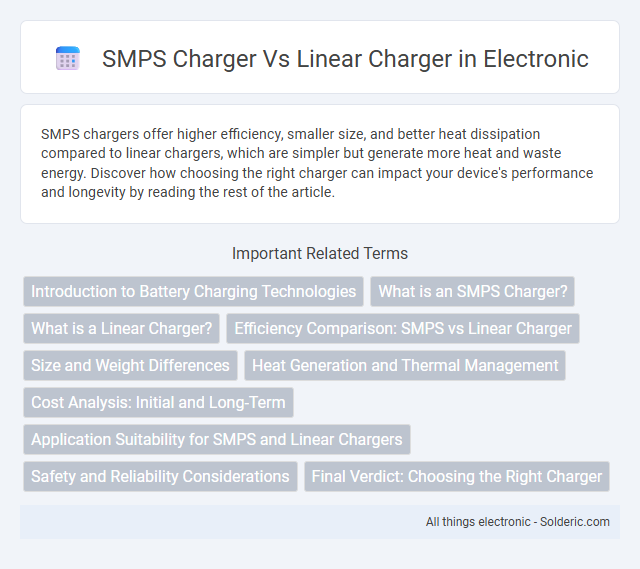SMPS chargers offer higher efficiency, smaller size, and better heat dissipation compared to linear chargers, which are simpler but generate more heat and waste energy. Discover how choosing the right charger can impact your device's performance and longevity by reading the rest of the article.
Comparison Table
| Feature | SMPS Charger | Linear Charger |
|---|---|---|
| Operating Principle | Switching regulator converts voltage with high efficiency | Uses linear regulator to drop voltage directly |
| Efficiency | High efficiency (80-95%) | Low efficiency (40-60%) |
| Heat Dissipation | Minimal heat generated | Significant heat generated, needs heat sink |
| Size | Compact and lightweight due to high efficiency | Larger due to heat sinks and components |
| Cost | Higher manufacturing cost | Lower cost and simpler design |
| Noise | May produce electromagnetic noise | Silent operation |
| Application | Best for portable and power-sensitive devices | Suitable for low power, noise-sensitive applications |
Introduction to Battery Charging Technologies
SMPS chargers use switching power supply technology to convert electrical energy efficiently, resulting in faster charging and less heat generation compared to linear chargers, which rely on dissipating excess voltage as heat for regulation. Linear chargers provide simpler circuitry and lower electromagnetic interference but are less energy-efficient and bulkier. Understanding these differences helps optimize your battery charging solutions for performance, cost, and application needs.
What is an SMPS Charger?
An SMPS charger, or Switch Mode Power Supply charger, efficiently converts electrical power using high-frequency switching regulators, resulting in smaller size and higher energy efficiency compared to linear chargers. It regulates voltage by rapidly switching components on and off, minimizing energy loss as heat and allowing for lighter, compact charger designs ideal for portable electronics. Your choice of an SMPS charger ensures faster charging with less power waste, making it a superior option for modern devices requiring reliable and efficient power management.
What is a Linear Charger?
A Linear Charger regulates voltage by dissipating excess power as heat through a series pass transistor, providing a simple and low-noise charging solution for batteries. Its design offers precise voltage control and reduced electromagnetic interference compared to SMPS chargers but tends to be less efficient and generates more heat, especially under high current conditions. Linear Chargers are ideal for small devices with low power demands where compact size and noise reduction are critical.
Efficiency Comparison: SMPS vs Linear Charger
SMPS chargers typically achieve efficiency rates between 80% to 95% by using high-frequency switching to minimize energy loss, whereas linear chargers generally operate at 50% to 60% efficiency due to voltage regulation through heat dissipation. The superior efficiency of SMPS chargers results in less heat generation and lower energy consumption, making them preferable for battery-powered devices and applications with stringent power constraints. Linear chargers, despite their simplicity and lower electromagnetic interference, remain less efficient, especially in scenarios with significant voltage differences between input and output.
Size and Weight Differences
SMPS chargers are significantly smaller and lighter than linear chargers due to their high-frequency switching technology, which reduces the need for bulky transformers and heavy heat sinks. This compact design enhances portability and convenience, making SMPS chargers ideal for modern electronic devices. Your choice of charger can impact device size and weight, especially in applications requiring mobility and space efficiency.
Heat Generation and Thermal Management
SMPS chargers generate significantly less heat compared to linear chargers due to their high efficiency and switching regulation, resulting in reduced power loss during voltage conversion. Linear chargers dissipate excess voltage as heat, leading to higher thermal output and necessitating larger heat sinks or enhanced cooling mechanisms. Effective thermal management in SMPS designs allows for compact charger sizes and improved reliability under varying load conditions.
Cost Analysis: Initial and Long-Term
SMPS chargers have a higher initial cost due to complex components and design but offer better energy efficiency, reducing electricity expenses over time. Linear chargers are cheaper upfront but generate more heat and waste energy, increasing operational costs and potentially shortening device lifespan. Long-term, SMPS chargers provide cost savings through lower power consumption and enhanced reliability despite the initial investment.
Application Suitability for SMPS and Linear Chargers
SMPS chargers are ideal for applications requiring high efficiency, compact size, and wide input voltage range, such as laptops, smartphones, and industrial equipment. Linear chargers suit low-power, noise-sensitive devices like audio equipment or simple battery charging where minimal electromagnetic interference is crucial. Choosing between SMPS and linear chargers depends on balancing efficiency, size, thermal management, and noise considerations specific to the application's requirements.
Safety and Reliability Considerations
SMPS chargers offer enhanced safety through built-in protection features like overvoltage, overcurrent, and thermal shutdown, reducing risks of damage or fire compared to linear chargers. Linear chargers have simpler designs with fewer failure points, often resulting in higher reliability under stable conditions but can overheat without proper heat dissipation. Your choice should balance the advanced safety mechanisms of SMPS chargers against the straightforward and consistent performance of linear chargers for reliable power delivery.
Final Verdict: Choosing the Right Charger
SMPS chargers offer higher efficiency, compact size, and better heat management compared to linear chargers, making them ideal for devices requiring fast and reliable power conversion. Linear chargers provide stable and low-noise output, which is beneficial for sensitive analog circuits but come with larger size and energy loss due to heat dissipation. Your choice depends on whether you prioritize efficiency and portability with SMPS or simplicity and minimal output noise with a linear charger.
SMPS charger vs Linear charger Infographic

 solderic.com
solderic.com